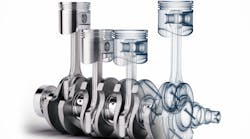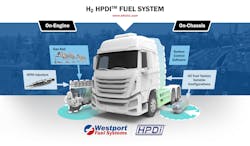Along with diesel, manufacturers are looking ahead at alternative-fuel engine solutions, including propane, natural gas, and hydrogen.
“The X15N big bore natural gas engine is essential to our commitment to improve NOx,” said Katie Zarich, director of on-highway communications at Cummins. “It produces up to a 10% fuel economy and GHG improvement over an ISX12N and can be specified with ratings matching diesels up to 500 HP and 1,850-lb.-ft. of torque. Its size is also reduced compared to a diesel X15 and it weighs more than 500 lbs. less than a current 15-liter diesel and is 200 lb. lighter than the current ISX12N.
“Our vision for a zero-emissions future includes internal combustion engines running on net zero-carbon fuels,” Zarich continued. “We expect to see alternative fuels play a significant role in the future as we ultimately transition to net-zero technologies. Propane is already widely distributed, is low cost per mile, and offers reduced greenhouse gas emissions. Natural gas, and particularly renewable natural gas, also offer significant environmental benefits. And there is tremendous momentum for hydrogen.”
Last year, Cummins unveiled a fuel-agnostic powertrain solution with a common architecture designed to provide the flexibility needed to start integrating low-carbon fuel technologies.
See also: Cummins reveals X10 fuel-agnostic engine for 2026
The H2 ICE low-emission internal combustion engine program, according to Zarich, allows for enabling next-generation fuel-agnostic midrange and heavy-duty engines by incorporating parts and components from existing platforms to drive cost advantages while also delivering reliability and durability equal to diesel. “H2 ICE will be familiar for our customers,” she said. “It looks like an engine, it sounds like an engine, it fits where an engine normally fits, and mechanics know how to work on it.”
Battery-electric and hydrogen-based power
At Detroit, product marketing manager Len Copeland noted the goal of offering only carbon-neutral vehicles by 2039 is centered on a dual-track strategy focused on battery-electric and hydrogen-based technologies. “Hydrogen can be the better solution for flexibility and particularly in demanding heavy-duty transport and long-haul applications,” he said. “The availability of corresponding infrastructure and sufficient green energy will be essential for a successful conversion to these zero-emissions technologies.”
Daimler Truck also has a joint venture with Volvo Trucks—an independent company called cellcentric—to accelerate the development and use of hydrogen-based fuel cells for heavy-duty commercial vehicles. Prototypes have been undergoing testing on tracks and public roads in Germany since last year, and a North American introduction is targeted for the end of the decade.
The company also has plans to collaborate with Cummins to upfit a Freightliner Cascadia with a Cummins hydrogen fuel cell powertrain for use in North America. Upon successful validation, initial seed units are intended to be available mid-decade.
As part of the Volvo Group, Mack also will be able to take advantage of any future advances in hydrogen fuel cell technologies that cellcentric develops, said Mack powertrain director Andrea Brown. “We already offer trucks that run on diesel, CNG, and electricity,” she added. “While diesel is the most popular fuel at the moment, we continue to monitor market conditions and local market regulations to deliver trucks that run on the fuel that best meets the needs of our customers.”
Navistar already offers the electric International eMV Series medium-duty truck and IC Bus CE Series school bus and has other zero-emissions solutions in development. “We believe battery-electric vehicles have a clear advantage over fuel cell electric vehicles,” said Navistar VP Chet Ciesielski. “But fuel cell electric vehicles also have a compelling use case in certain applications to make the best use of clean energy resources.”
See also: Navistar’s new powertrain advances emission control
Renewable diesel, biogas, and green hydrogen
At Volvo Trucks, current offerings include renewable diesel and biogas driven products, and work is underway to develop fuel cell technology that can utilize green hydrogen. “There will be a need for a combustion engine running on renewable diesel and biofuels as a complement to battery electric and fuel cell electric trucks,” said John Bartel, director, product strategy-driveline. “Green hydrogen is another potential fuel source that could be used in a fuel cell electric or internal combustion engine.
“The different bio and renewable fuels have pros and cons in terms of their potential to replace diesel and their climate benefit,” Bartel added. “But we believe the road to a decarbonized transportation future falls within various paths and that there is not a single solution to fit all applications.”
For Cummins, a key challenge will be matching technology and infrastructure readiness. “While we see investment in infrastructure taking place, much more will be required to allow for adequate support of these new technologies,” Zarich said.
“OEMs have to plan out their long-term investments,” Ciesielski said. “Future solutions will require a much broader group of stakeholders to help build out an ecosystem that is supportive of new technologies.”
Propane and natural gas updates
Already proven in a variety of truck applications, propane and natural gas fuel system adoption and development is continuing.
In 2022, Roush CleanTech achieved its second emission-reducing certification for a Ford 7.3-liter V8 engine. Earlier, the company’s propane engine in Blue Bird buses was certified to the optional ultra-low nitrogen oxides of 0.02g for the 2022 model year and beyond, making it 90% cleaner than today’s emissions requirements.
The certification addresses the standard for reducing emissions from escaping the tank during refueling. For propane buses, the requirement is met by using a low-emissions quick-connect fill valve, which limits fuel vapors in the atmosphere.
In other propane news, Power Solutions International (PSI) announced that the Port Newark Container Terminal (PNCT) in Newark, New Jersey, after initial success with a prototype propane-powered port tractor, decided to move ahead with replacing its entire diesel-powered port tractor fleet and convert to propane. Throughout December, PNCT conducted a side-by-side analysis of a MAFI propane port tractor with current diesel models. The comparison accounted for fuel efficiency, run time, torque, power, and emissions output.
See also: EPA’s new HD emissions rules push manufacturers and fleets to plan ahead
The MAFI port tractor is powered by PSI’s 8.8-liter, 270-HP/565 lb.-ft. propane engine that is certified by the U.S. EPA and California Air Resources Board (CARB) to 0.02 grams of NOx per brake horsepower-hour (g/bhp-hr) in mobile, off-road applications. The spark-ignited, water-cooled engine can run on propane, natural gas, or gasoline.Westport Fuel Systems offers its HPDI fuel system technology enabling heavy-duty trucks to operate on alternative low-carbon fuels with the same power, torque, efficiency, and performance as diesel engines. The system delivers a significant tank-to-tailpipe CO2 reduction over diesel, the manufacturer stated.
The HPDI fuel system technology uses compression ignition combustion initiated via late cycle direct injection of a small quantity of pilot fuel, followed by direct injection of a primary gaseous fuel, including methane, bio-methane, or hydrogen.
“Westport HPDI is a compelling technology when compared to fuel cell and battery electric vehicles, delivering a lightweight and simple modification available today for current internal combustion engines,” said Westport CEO David Johnson. “The system is cost-effective for OEMs to industrialize and affordable for fleets to acquire while offering near-zero greenhouse gas emissions for heavy-duty, long-haul trucking.”
This article originally appeared in Fleet Maintenance, a FleetOwner sister publication.





